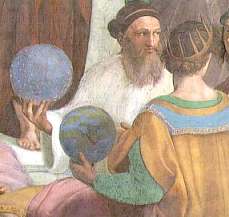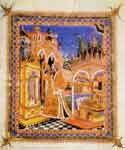.
Die Astronomie des Klaudius Ptolemaios
Ptolemy created a universe that lasted a thousand years. Copernicus created a universe that lasted four hundred years. Einstein has created a universe, and I can't tell you how long it will last. George Bernard Shaw
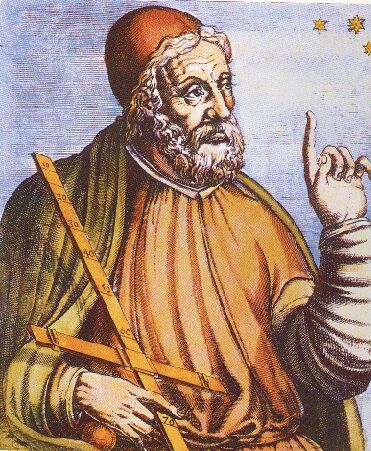
Ptolemy (or Claudius Ptolemaeus or Klaudios Ptolemaios) (Πτολεμαίος Κλαύδιος, Πτολεμαίος Κλαύδιος) lived in Alexandria, Egypt, from approx. 87 to probably 170 AD. Very little is known about his personal life. He was probably born in the Hellenistic city of Ptolemais Hermii on the Nile in Upper Egypt.
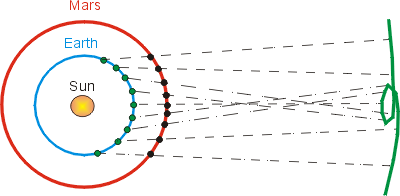
The orbit of a Planet, like Mars, around the Sun although it is an ellipse (here simplified by a circle) seems to bee more complex (green line) as seen from the Earth. The figure explains why it seems that the planet changes its direction. The lines connecting the Earth and Mars show the direction we have to see to observe Mars. As time passes these lines define the orbit of Mars as seen from the Earth. Mars looks as if it moves sometimes back changing its direction and moving on a loop. Planetary orbits are complex in a geocentric world model, like that of Ptolemy. For the Earth the orbit around the Sun is almost circular.
Ptolemy was an astronomer, mathematician and geographer. He codified the Greek geocentric view of the universe, and rationalized the apparent motions of the planets as they were known in his time. Ptolemy synthesized and extended Hipparchus's system of epicycles and eccentric circles to explain his geocentric theory of the solar system. Ptolemy's system involved at least 80 epicycles to explain the motions of the Sun, the Moon, and the five planets known in his time. The circle was considered as the ideal orbit even if Hipparchus proposed an eccentric motion. It was only Kepler who finally showed that the planet orbits are elliptic and not spherical.
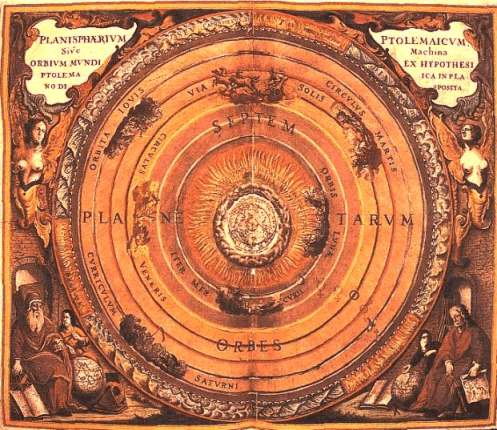
The Ptolemaic Cosmological model with the Planets and Sun moving around the Earth as the center of the World. The universe is divided in eight concentric spherical shells, one in which all the stars were fixed, and one for each of the seven planets (Poseidon and Pluto were not known). The sphere of the stars rotate daily around the motionless earth.
Ptolemy’s Cosmology , See also with zoom to the maximum possible :-)
. Some say that actually he knew that his model was only a system with many parameters to describe the astronomic phenomena. This system became known as the Ptolemaic system. It predicts the positions of the planets accurately enough for naked-eye observations This is described in the book Mathematical Syntaxis (widely called the Almagest), a 13 book (chapters) mathematical treatment of the phenomena of astronomy. It contains a myriad of information ranging from earth conceptions to sun, moon, and star movement as well as eclipses and a breakdown on the length of months.
The 13 chapters of the Almagest according to a lecture:
1-2: Motion of the celestial sphere, table of chords
3-4: Length of the year and month, solar theory, theory of the motion of the Moon
5: Construction of the astrolab
6: Theory of eclipses
7-8: Precession, Catalog of 1022 stars and nebular, (Magnitude, Number of stars): (1m,15), (2m,45), (3m, 208), (4m , 474), (5m, 217), (6m, 49) 9-13: Theory of Planetary motion
A summary of Ptolemy's theory was published earlier in the Canobic Inscription in 147-148 AD. The Almagest also included a star catalog containing 48 constellations, using the names we still use today. Each book deals with certain astronomical concepts pertaining to stars and to objects in the solar system (the Earth and all other celestial bodies that revolve around the Sun). It was the encyclopedic nature of the work that made the Almagest so useful to later astronomers and that gave the views contained in it so profound an influence. It is a synthesis of the results obtained by Greek astronomy; it is also the major source of knowledge about the work of Hipparchus. The word Almagest is a synthesis of the Arabic al and the Greek mega (or great). Ptolemy's work was translated by the Arabs 700 years after his death. Due to some measurements errors and the accuracy of his model some deviations between predicted and observed valued were found. Arab astronomers extended and corrected his model but kept the geocentric character. Was the authority of Aristotle so strong that Ptolemy and other for more than 1200 years did not adopt the heliocentric model of Aristarchus?
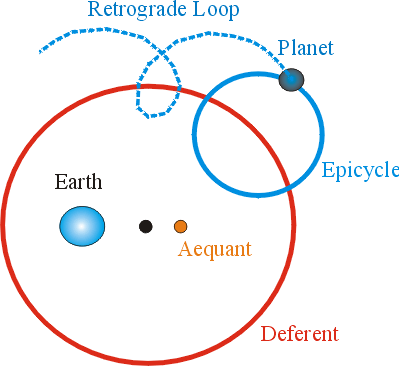
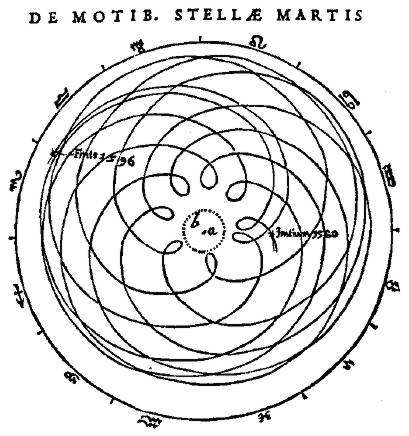
Ptolemy used a complex mechanism using eccentric circles and epicycles to describe accurately the planetary motion in a geocentric model. The eccentric is the true center of planet motion and not the Earth (Aristotle considered the Earth in the center). The planet moves uniformly in relation to the Aequant,or Equant (not the Earth). This system was necessary to describe the actual elliptic orbits of the planets around the sun in Ptolemy's Earth-center model using a combination of eccentric circular orbits. The right image shows the orbit of Mars from 1580-1586 according to Kepler in Astronomia Nova (1619)
Although it is difficult to determine which findings are those of Ptolemy and which are those of Hipparchus, Ptolemy did extend some of the work of Hipparchus through his own observations, apparently using somewhat similar instruments. For example, whereas Hipparchus had compiled a star catalog (the first of its kind) containing 850 stars, Ptolemy expanded the number in his own catalog to 1022 stars. According to Olympiodoros Ptolemy made astronomical observations at Canopus a place 20 kilometer northeast of Alexandria over a period of 40 years. There are many experts which have doubts and even say that he “manipulated” the data or used some extrapolations methods and older data to produce his catalog (Example).
Boethius translated the Almagest into Latin although his translation was lost and so in the early years this work was ignored in the West. In the late 820s Ptolemy's Almagest was translated into Arabic. The Ptolemaic explanation of the motions of the planets remained the accepted wisdom until the Polish scholar Copernicus proposed a heliocentric view in 1543. It should be noted, too, that Ptolemy's system is actually more accurate than Copernicus's. The heliocentric formulation does not improve on Ptolemy's until Kepler's Laws are also added.
Well do I know that I am mortal, a creature of one day.
But if my mind follows the winding paths of the stars
Then my feet no longer rest on earth, but standing by
Zeus himself I take my fill of ambrosia, the divine dish.
Claudius Ptolemy (Scott Hildreth, ISLS Colloquium - Autumn 2003)
Back view of Ptolemy holding the Earth sphere in the School of Athens, facing Strabo (some say Zoroaster, represented as an astrologer), holding a celestial sphere. An explanation is that Raphael used the motif of the crown found on coins from the "dynasty of Macedonian kings of the same name who ruled Egypt from 323 to 30 BC
Like in Astronomy with his Almagest he was famous for his Geography book. He also wrote other books such as Optics, Procheiroi Kanones (the Handy Tables), Hypotheseis ton planomenon (The Planetary Hypotheses), The Harmonics, Phaseis aplanon asteron kai synagoge episemasion (phases of fixed stars and collection of weather-changes) and On the Criterion. Ptolemy has written also a book about astrology, that is known as the Tetrabiblos.
Ptolemy Constellations:
Andromeda | Aquarius | Aquila | Ara | Argo (Carina , Puppis , Pyxis, Vela) | Auriga | Boötes | Cancer | Canis Major | Canis Minor | Capricornus | Cassiopeia | Centaurus | Cepheus | Cetus | Corona Australis | Corona Borealis | Corvus | Crater | Cygnus | Delphinus | Draco | Equuleus | Eridanus | Gemini | Hercules | Hydra | Leo | Lepus | Libra | Lupus | Lyra | Ophiuchus / Serpentarius | Orion | Pegasus | Perseus | Pisces | Piscis Austrinus | Sagitta | Sagittarius | Scorpius | Serpens | | Taurus | Triangulum | Ursa Major | Ursa Minor | Virgo |
Translation of Book 1 part 1 of the Planetary Hypotheses [based on Heiberg's Greek text]
Translation of the Canobic Inscription.
See also:
http://www.chass.utoronto.ca/~ajones/ptolgeog/biography.html A list of observations by Ptolemy (with manipulations ?)
Ptolemy's Spherical Astrolabe (Armillary Sphere) and Ptolemy's Equatorial Ring
Ptolemy's Inscribed Quadrilateral Theorem
Ptolemy the Geographer and his Maps
Ancient Greece: Did Hipparchus discover Newtons gravity and inverse square law?
Ancient Greece: Astronomy discoveries
Archytas “proof” of a infinite universe
The Many Worlds and existence of extraterrestrial life theory of Democritus, Epicurus and others
The Fractal Cosmos of Anaxagoras (In Preparation)
Distance Measurements by Eratosthenes and Posidonius
a) Hipparchus method to measure the Earth-Moon distance , b) Hipparchus fails to measure the stellar parallax
LINKS
Retrograde Motion, Animations and explanations
Models of Planetary Motion from Antiquity to the Renaissance
Almagest Ephemeris Calculator
Star Catalogue of Ptolemy
Ptolemy's Epicycles
Ptolemy on Astrolabes
Ptolemy on Sundials
Astronomy Nobel Prize for Ptolemy and others
Claudius Ptolemy Astronomy
Ptolemy: Derivation of the position of the center of the solar deferent on the eccentric model.
Mathematica Package: Ptolemy's Chord Table
Astronomical Papyri from Oxyrhynchus
The Ptolemy-Venus Double-Date: Did His Proofs HAVE to Cheat? (PDF File)
Works of Claudius Ptolemy together with commentators on his works (Preliminary version)
Dennis Duke, The Measurement Method of the Almagest Stars
PTOLEMY'S FAILINGS, The Crime of Claudius, Ptolemy
Some articles on the history of ancient astronomy (including Ptolemy) , The Zodiacal Armillary Sphere
Ancient Planetary Model Animations
Brendan, Brother T, How Ptolemy Constructed Trigonometry Tables, Mathematics Teacher 58, 141 – 49 (1965).
Robert R. Newton, The Crime of Claudius Ptolemy, Baltimore : Johns Hopkins University Press, 1977.
Ptolemy Constellations
Andromeda | Aquarius | Aquila | Ara | Argo Navis | Aries | Auriga | Boötes | Cancer | Canis Major | Canis Minor | Capricornus | Cassiopeia | Centaurus | Cepheus | Cetus | Corona Australis | Corona Borealis | Corvus | Crater | Cygnus | Delphinus | Draco | Equuleus | Eridanus | | Gemini | | Hercules | | Hydra | | Leo | Lepus | Libra | Lupus | Lyra | Ophiuchus | Orion | | Pegasus | Perseus | Pisces | Piscis Austrinus | Sagitta | Sagittarius | Scorpius | | Serpens | | Taurus | Triangulum | Ursa Major | Ursa Minor | | Virgo |
Owen Gingerich , Ptolemy's "Almagest" , Princeton University Press (October 19, 1998) ISBN: 0691002606
C.M. Linton. From Eudoxus to Einstein : A History of Mathematical Astronomy C.M. Linton. Cambridge, UK ; New York : Cambridge University Press, 2004
Greek Astronomy , Heath, Dover Publications, Incorporated, 1991 reprint (from 1932 original)
| Ancient Greece
Science, Technology , Medicine , Warfare, , Biographies , Life , Cities/Places/Maps , Arts , Literature , Philosophy ,Olympics, Mythology , History , Images Medieval Greece / Byzantine Empire Science, Technology, Arts, , Warfare , Literature, Biographies, Icons, History Modern Greece Cities, Islands, Regions, Fauna/Flora ,Biographies , History , Warfare, Science/Technology, Literature, Music , Arts , Film/Actors , Sport , Fashion --- |

